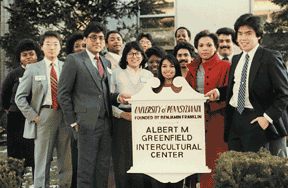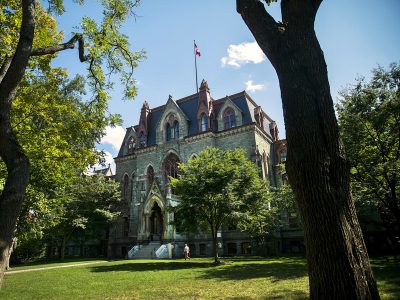
Anniversary | November’s “Hip Hop Across Cultures” conference marks the official conclusion of the 20th anniversary of the Greenfield Intercultural Center, but the yearlong series of events celebrating that milestone has also been a new beginning of sorts for the campus organization dedicated to “fostering dialogue and cultural alliances on campus.”
“The general theme [with] these anniversary events is that people say, ‘You know what? I forgot how special it was, and when I think back to the people I’m still friends with I realized I met some of them at the GIC,’” says center director Valerie De Cruz. She’s been contacted by many alumni looking to reconnect with the GIC and with old friends, to volunteer, or to add their memories to the center’s history, she adds.
The GIC’s roots go back to a 1977 student proposal for a “Third World Center” that later became an issue in the 1978 sit-in, in which students occupied College Hall and the Franklin Building. An intercultural center gained the approval of the University administration in 1982, during the presidency of Dr. Sheldon Hackney Hon’93, and with support from the Albert M. Greenfield Foundation, the GIC opened in January 1984 in a renovated 140-year old building at 3708 Chestnut Street, which remains its home today.
GIC provides facilities and support for the United Minorities Council (itself born out of that 1978 protest) and also sponsors a variety of educational forums and classes. These include programs exploring the partnership among Blacks and Jews in the civil rights era (Alliance and Understanding), issues of race and privilege (Race Dialogue Project), strengthening communication and collaboration between communities of color at Penn and the Lesbian Gay Bisexual Transgender Center (Seeking Common Ground), and the Programs for Awareness in Cultural Education (PACE), an intensive course designed to facilitate understanding and cross-cultural dialogue. These programs, says De Cruz, are the “soul of the place.”
The GIC’s history was given life and warmth at last winter’s anniversary kickoff event—20 Years of the GIC … Then and Now—in which former directors and staff, alumni, and current students shared their memories and talked about what GIC meant to them. Participants called it their “home away from home” on Penn’s campus; “holy ground”; and, using the campus shorthand for interest centers like the Writers, Civic, and Tech houses, “the granddaddy of all ‘hubs.’” “In the GIC’s walls, there’s something very special,” one summed up.
In the case of Marc Rodriguez C’83, the memory was of the struggle to make the GIC a reality as a student activist and chair of the UMC. “I don’t know what it’s like to be here, because we didn’t have this,” he said. For students of color at Penn 20 years ago, “GIC was the light at the end of the tunnel, unattainable in 1979 and attainable in 1983 and soon after that.”
Rodriguez had mixed feelings about the toll that activism took on his academic career (“I went to more meetings than I did classes, and I don’t know if that’s a good thing”) and expressed the hope that today’s students do a better job of balancing the social, spiritual, and professional aspects of their lives on campus. But any doubts about whether the effort was worth it were dispelled when he overheard a current Penn student “talking about taking a course on Latino politics in the U.S.,” he said. “What we wouldn’t have given for a course like that or a building like this one—ask me if I’d do it again, and I would start tomorrow.”
The Center’s founding director, Rene Gonzalez, and his wife, Edna Dominguez, recalled GIC’s first decade, which included times of controversy—such as over an invitation to Rev. Louis Farrakhan to speak on campus—as well as more homely cultural exchanges like the couple’s introducing the Penn community to Texas barbecue and fajitas.
Citing the “natural tension” between roles as a student advocate and University administrator, Gonzalez admitted there were “some days I just wanted to pack it up because I was getting hit by both—but I knew that coming in,” he added. “One of the things I enjoyed the most was working through those challenges to achieve a balance between what the students wanted and what I thought, long term, the center could do.”
Dr. Joseph Sun, director of academic affairs at the School of Engineering and Applied Science, who served for a year as interim GIC director in 1993-94, called the experience the most fulfilling of his Penn career. “I really saw my job as enabling the students to get done whatever they wanted to do,” he said. “That mix of enabling and advocating was just a very good place to be.”
“I literally slept here sometimes, ate here, danced here to Snoop Dog and salsa in the same week,” said Rev. Charles L. (“Chaz”) Howard C’00, now a minister and chaplain at the Hospital of the University of Pennsylvania, who was UMC chair in his sophomore through senior years. “[I] cried here, learned things about myself here. This is holy ground, and the work that you all did to get this place up was not in vain, and the work that you are doing to keep this place up is very special work.”
Jen Kwon C’02, another former chair of the UMC, described how she first encountered the GIC through the PACE course. Struggling to fulfill the requirement that participants write an autobiography, she found herself telling about how, when she was in the third grade and “going through a stage where I just wanted to be like everyone else,” she changed her name from the Korean one her parents had given her at birth—in English, it translated as talented pearl—to Jen. “I had never told anyone, and here I was sharing it with 20 other people,” she said. “That’s what the class is able to do—to get people to open up and come forward and share and find that common ground and make those linkages.”
Current UMC Chair Carlos Rivera-Anaya, a junior in the College, called the other panelists “inspiring.” (He also assured Marc Rodriguez that “the meetings do not stop.”) His own involvement, he said, began as “an awkward freshman looking for that work-study job coming in [to GIC]—and I haven’t left” since. He repeated a friend’s remark that “in the GIC walls, there’s something very special” that “invokes dialogue and invokes a different way of thinking,” one that is “innovative and revisionist and reflective all at once.”
Today’s campus environment, according to GIC director Valerie De Cruz, is increasingly diverse. “There have always been minority students and white students, but the population of those two groups have gotten more rich and varied. There are a lot more Asian and Arab students involved now, there are a lot of students who are of multiple heritage,” she says. At the same time, many white students have a more sophisticated understanding of diversity and race, she adds, “but the desire to have this multicultural community and for Penn to be this multicultural community is still the same.”
As in the past, minority recruitment is a concern, De Cruz says, noting that enrollment numbers for Black and Latino students have not improved markedly and “in some cases it’s lower compared to some years.” Students from less affluent backgrounds who are the first in their families to go to college still face an “enormous struggle” in attending Penn, she adds. For students of color whose economic background is more well-off or whose parents may have gone to Penn or similar institutions, the expectations for their college experience are similar to their white peers—and that means high.
“They come with the same sense of entitlement as the rest of the student body: ‘I expect not just that I’m going to get by. I want to thrive. I want the mentoring from faculty. I want all of the opportunities that are out there for other students. I want to be competitive for those premier scholarships and fellowships.’ There’s much more of that.”
One thing that has changed in recent years is that many students have talked about race in their high schools, De Cruz says, “which I didn’t hear 15 years ago when I started doing this work.” Back then, college campuses were the “first place we were talking about race and diversity and attempting to talk about it in its complexities—and not always doing that work very well.”
Many of today’s students “have chosen Penn because Penn promised them a certain kind of urban, diverse, eclectic Ivy League experience, and some of them—a few of them—find it in various niches,” she says, but “many students—White, Latino, Asian, Black—lament the fact that there’s not enough of that.”
Students in the 10-year-old PACE program, offered in collaboration with the Graduate School of Education, “do look at issues around diversity, configured broadly—not just race, but disability, class, all kinds of issues,” De Cruz says. Students pair up and research an issue they are passionate about. “They do the research and present and talk about it in class,” she says. “There’s a lot of challenging of each other’s notions.”
The quality of the instructors—and their willingness to let discussion range freely—is essential, De Cruz says. “Only occasionally do you come across someone who won’t shove things under the rug or will know what to do with a very emotionally laden topic.”
One group of PACE students recently created a video that uses the “water buffalo incident” of 1993 as context for a discussion of the current state of “race relations at Penn and [to talk] about culture and diversity,” says De Cruz. Called Other Side of Perfect, it will be screened during Unity Week this fall and as the semester unfolds. After 9/11, GIC also helped to produce a video on Arab Americans in Philadelphia that is being used in community groups and schools and has also been broadcast on cable TV. And this past summer the Center assisted students exploring the issues of homelessness to develop a video designed to educate their peers on the experiences and struggles of Philadelphia’s homeless population, says De Cruz.
GIC Associate Director Sean Vereen calls the anniversary “our effort to delve into a part of the history of this institution and reflect on accomplishments that haven’t been formally acknowledged in Penn’s history.” The students and others who pushed for the establishment of the UMC and GIC are “founding mothers and fathers” who laid the foundation for making Penn a more multicultural institution, he says. “The test for Penn is whether in 2050 we can look back and say we have truly equipped all Penn students to thrive in our increasingly diverse society and collaborate constructively in our global community.” —J.P.




